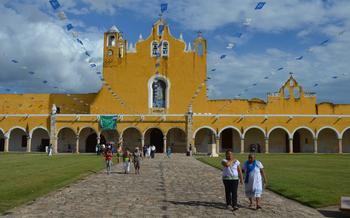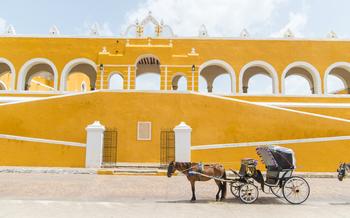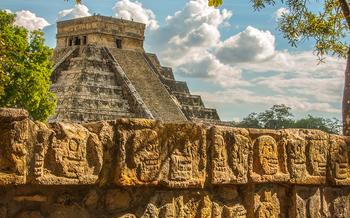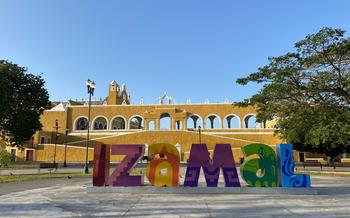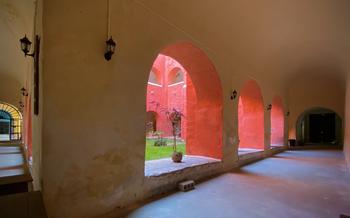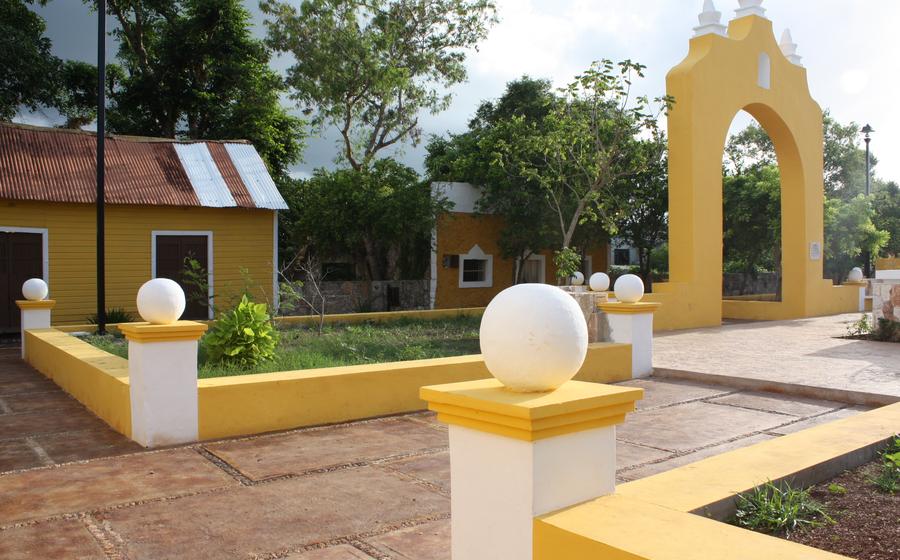
Cenote Ik Kil (Nearby city)
- Izamal: City of Convents and Cenotes
- Cenote Ik Kil: A Sacred Mayan Cenote
- Exploring the Cenote's Caves
- Taking Photos and Videos at Cenote Ik Kil
- Visiting Cenote Ik Kil with a Tour
- Planning Your Visit to Cenote Ik Kil
- Other Cenotes Near Izamal
- Day Trips from Izamal to Nearby Cenotes
- Cultural Significance of Cenotes in Mexico
- Conservation and Sustainability of Cenotes
Izamal: City of Convents and Cenotes
Izamal, a charming city nestled in the heart of Mexico's Yucatan Peninsula, captivates visitors with its unique blend of Mayan and colonial heritage. Known as the "City of Convents," Izamal boasts a rich history dating back to the pre-Hispanic era, when it served as a significant religious center for the ancient Mayans. Today, the city's colonial architecture, vibrant culture, and proximity to stunning cenotes make it a popular destination for travelers seeking an authentic Mexican experience.
Location and Access: Izamal is conveniently located just 70 kilometers (43 miles) from Merida, the capital of Yucatan. The city is easily accessible by car, with well-maintained roads connecting it to major highways. Visitors can also opt for a scenic train ride from Merida, offering a glimpse of the picturesque countryside along the way.
Things to Do in Izamal: Stroll through the city's enchanting streets, admiring the vibrant yellow facades of colonial buildings that give Izamal its distinctive charm. Visit the historic Convento de San Antonio de Padua, the largest convent in the Americas, and marvel at its impressive architecture and religious artifacts. Immerse yourself in the city's vibrant culture by exploring the bustling markets, savoring delicious local cuisine, and engaging with friendly locals.
Where to Stay and Eat in Izamal: Izamal offers a range of accommodation options, from budget-friendly hostels to charming boutique hotels. Indulge in the city's culinary delights at local restaurants serving traditional Yucatecan dishes, such as cochinita pibil, panuchos, and salbutes. Be sure to try the refreshing aguas frescas, made with local fruits, to quench your thirst on a hot day.
Cenote Ik Kil: A Sacred Mayan Cenote
Cenote Ik Kil is a sacred cenote located near the town of Izamal in the Yucatan Peninsula of Mexico. It is one of the most popular cenotes in the region due to its stunning beauty and crystal-clear waters. The cenote is surrounded by lush vegetation, creating a magical and serene atmosphere.
For the ancient Maya, cenotes were considered sacred portals to the underworld. They believed that cenotes were the homes of water spirits and that offerings should be made to them to ensure a good harvest and safe travels. Many artifacts, including jewelry, pottery, and human remains, have been found in Cenote Ik Kil, suggesting that it was an important ceremonial site for the Maya.
Exploring the Cenote's Caves
The allure of Cenote Ik Kil extends beyond its refreshing waters; its subterranean caves beckon adventurers to delve into the depths of the earth. These caves, carved by the relentless flow of water, offer a glimpse into the hidden world beneath the cenote's surface.
Types of Caves Found in Cenote Ik Kil
Cenote Ik Kil boasts a diverse array of caves, each with its unique characteristics. The most common type is the dry cave, which remains above the water level, providing a safe and accessible environment for exploration. These caves often feature intricate stalactite and stalagmite formations that have been sculpted over millennia.
In contrast, wet caves are partially or entirely submerged in water, requiring visitors to wade or swim to explore them. These caves offer a more challenging and immersive experience, allowing adventurers to witness the underwater world of the cenote up close.
Guided vs. Unguided Cave Exploration
For those seeking a guided experience, several tour operators offer cave tours that delve into the depths of Cenote Ik Kil. These tours are led by experienced guides who provide insights into the geology, history, and ecology of the caves. They also ensure the safety of visitors by providing proper equipment and instruction.
For more experienced and adventurous travelers, unguided cave exploration is an option. However, it is essential to exercise caution and take proper safety precautions, such as bringing appropriate equipment, following established trails, and informing someone of your exploration plans.
Safety Precautions for Cave Exploration
Before embarking on a cave exploration adventure, it is crucial to prioritize safety. Here are some essential precautions to take:
-
Proper Equipment: Bring a helmet, headlamp, and sturdy footwear with good traction. Consider renting or purchasing waterproof flashlights for underwater exploration.
-
Follow Established Trails: Stick to marked trails and avoid venturing into uncharted territory. Caves can be complex and disorienting, and getting lost is a real risk.
-
Inform Someone of Your Plans: Let someone know your intended route and expected return time. This way, if something goes wrong, help can be sent promptly.
What to Bring for Cave Exploration
In addition to safety equipment, consider bringing the following items for a more enjoyable and rewarding cave exploration experience:
-
Camera: Capture the stunning beauty of the caves with a waterproof camera or a waterproof housing for your camera.
-
Water and Snacks: Stay hydrated and energized with plenty of water and snacks, especially if you plan on spending several hours exploring.
-
First-Aid Kit: Pack a basic first-aid kit in case of minor injuries or ailments.
With proper preparation and precautions, exploring the caves of Cenote Ik Kil can be a thrilling and unforgettable experience that allows you to discover the hidden wonders beneath the surface of this sacred Mayan cenote.
Taking Photos and Videos at Cenote Ik Kil
With its stunning turquoise waters, lush vegetation, and dramatic rock formations, Cenote Ik Kil is a photographer's paradise. Here are some tips for capturing the best photos and videos of this natural wonder:
-
Best Time of Day for Photography: The best time to take photos and videos at Cenote Ik Kil is during the early morning or late afternoon when the sun is lower in the sky and the light is softer. This will help you avoid harsh shadows and overexposed highlights.
-
Camera Settings and Equipment: Use a wide-angle lens to capture the cenote's vastness and depth. A tripod is recommended for stability, especially if you're shooting long exposures or using a slow shutter speed.
-
Underwater Photography Tips: If you have a waterproof camera or housing, take advantage of the opportunity to capture underwater shots of the cenote's crystal-clear waters and diverse marine life. Use a strobe or external lighting to enhance the colors and visibility underwater.
-
Tips for Capturing Unique Shots: Look for creative angles and perspectives to make your photos stand out. Experiment with different vantage points, such as shooting from the cenote's edge, from the water's surface, or even from underwater.
Visiting Cenote Ik Kil with a Tour
Visiting Cenote Ik Kil with a tour offers several advantages, especially for first-time visitors or those short on time. Tour operators provide a hassle-free experience, taking care of transportation, entrance fees, and guiding you through the cenote's highlights.
When choosing a tour operator, consider factors like reputation, group size, and the itinerary offered. Look for tours that include pickup and drop-off from your hotel in Izamal, as well as a knowledgeable guide who can share insights into the history, culture, and geology of the cenote.
Typical tours to Cenote Ik Kil include a guided walk to the cenote, a briefing on safety guidelines, and ample time for swimming, snorkeling, and cliff jumping. Some tours may also offer additional activities like zip-lining or exploring nearby caves.
The cost of tours varies depending on the operator and the inclusions. Expect to pay around $50-75 per person for a half-day tour, which typically lasts 3-4 hours. Tours are available throughout the year, but it's advisable to book in advance, especially during peak season.
Planning Your Visit to Cenote Ik Kil
Visiting Cenote Ik Kil requires careful planning to ensure a safe and enjoyable experience. Here are some essential tips to consider when organizing your trip:
-
Best time to visit: The ideal time to visit Cenote Ik Kil is during the shoulder seasons (April-May and September-October) when the weather is pleasant, and tourist crowds are smaller. Avoiding the peak season (December-March) will allow you to experience the cenote's beauty without the overwhelming crowds.
-
How much time to allocate: Allocate at least two to three hours for your visit to Cenote Ik Kil. This will give you ample time to swim, snorkel, explore the caves, and relax on the sunbathing platforms. If you plan to take a tour, factor in additional time for the guided activities.
-
What to wear and bring: Pack comfortable swimwear, a towel, and a change of clothes. Water shoes or sandals are recommended for navigating the cenote's rocky surfaces. Bring sunscreen, sunglasses, and a hat to protect yourself from the sun. Consider bringing a waterproof camera or a GoPro to capture your underwater adventures.
-
Avoiding crowds and peak season: To avoid the peak tourist season and crowds, plan your visit during weekdays instead of weekends. Arriving early in the morning or late afternoon can also help you beat the rush. Consider visiting other nearby cenotes like Cenote Xkeken or Cenote Suytun, which are less crowded but offer equally stunning experiences.
Other Cenotes Near Izamal
Beyond the popular Cenote Ik Kil, the surroundings of Izamal offer a treasure trove of otherworldly cenotes, each with its unique charm and allure. Immerse yourself in the mystical waters of Cenote Xkeken, a secluded gem nestled amidst lush vegetation. Discover the hidden chambers and stalactite formations of Cenote Suytun, accessible through a narrow opening that leads to a breathtaking subterranean world. For a refreshing swim in a tranquil setting, head to Cenote Hubiku, where crystal-clear waters and vibrant aquatic life await. And if you seek an adventurous spelunking experience, venture into the depths of Cenote Lol-tun, renowned for its impressive cave systems and ancient Mayan artifacts.
Day Trips from Izamal to Nearby Cenotes
If you have more time to explore, consider taking a day trip from Izamal to visit other cenotes in the surrounding area. Several tour operators offer guided excursions to various cenotes, including transportation, lunch, and snorkeling gear. These tours typically range in price from $50 to $100 per person, depending on the number of cenotes visited and the duration of the tour.
On a typical day trip, you can expect to visit two or three cenotes, each with its unique features and charm. Some cenotes may be more suitable for swimming and snorkeling, while others may be better for cave exploration or simply relaxing and taking in the scenery. Your tour guide will provide you with information about each cenote and help you choose the activities that are best suited to your interests.
To make the most of your day trip, be sure to pack comfortable clothing, swimwear, sunscreen, insect repellent, and a camera. You may also want to bring a towel, snorkel mask, and fins if you plan on snorkeling. It's also a good idea to bring some snacks and drinks, as food and beverage options may be limited at the cenotes.
Cultural Significance of Cenotes in Mexico
Cenotes hold a deep cultural and religious significance for the people of Mexico. In Mayan mythology, cenotes were considered sacred portals to the underworld, known as Xibalba. The Mayans believed that cenotes were inhabited by water spirits and deities, and they often performed rituals and ceremonies at these sites to honor these spirits and ask for their protection.
Cenotes were also an important source of water for the Mayans, who relied on them for drinking, bathing, and irrigation. During the dry season, when other water sources were scarce, cenotes were essential for the survival of the Mayan people.
Today, cenotes continue to be an important part of Mexican culture. They are popular tourist destinations, and many Mexicans visit cenotes to swim, snorkel, and explore the caves. Cenotes are also used for religious ceremonies and rituals, and they are considered to be sacred places by many indigenous communities.
Conservation and Sustainability of Cenotes
Cenotes are unique and fragile ecosystems that require careful conservation and sustainability efforts. Unfortunately, cenotes face various threats, including pollution, over-tourism, and climate change.
Pollution is a significant concern, as cenotes are susceptible to contamination from agricultural runoff, sewage, and littering. Over-tourism can also lead to environmental degradation, as excessive foot traffic and swimming can damage cenote formations and disturb wildlife. Climate change poses another threat, as rising temperatures and changing rainfall patterns can affect cenote water levels and ecosystems.
To protect cenotes, various conservation efforts are underway. These include establishing protected areas, implementing water quality monitoring programs, and promoting responsible tourism practices. Travelers can contribute to sustainability by following guidelines such as staying on designated trails, avoiding the use of sunscreen and insect repellent in cenotes, and properly disposing of waste.
By working together, we can help preserve these natural wonders for future generations to enjoy.



